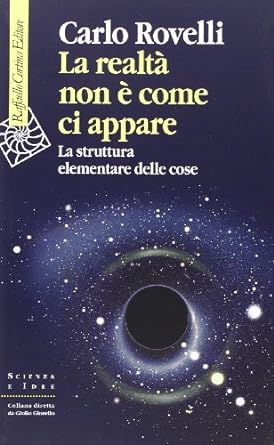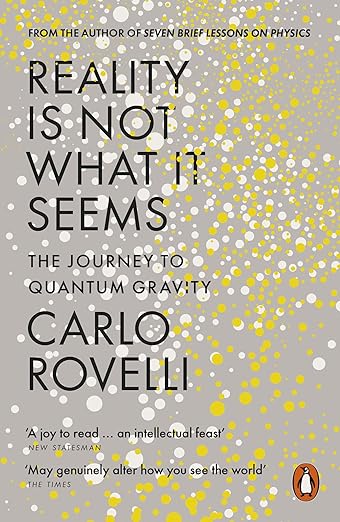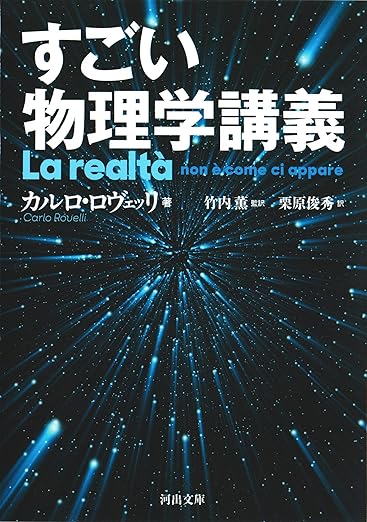


すごい物理学講義 (Time doesn’t exist)
by Carlo Rovelli
書評「めぐりあう書物たち」 (Book review ”Book come across”)
by 尾関章 (Akira Ozeki)
In this column, we often cover one book over two weeks. At first, I advocated reading one book a week, but I started to think it was ridiculous to earn that many books that way. Sometimes one book every two weeks is enough. Well, sometimes it’s okay to read one book every three weeks or one book every four weeks.
So this week, I will continue with “Amazing Physics Lectures” (written by Carlo Rovelli, translated by Kaoru Takeuchi, translated by Toshihide Kurihara, published by Kawade Bunko, 2019). The reason why I linger so long on one book is because I want to get to the bottom of the loop quantum gravity theory that the author talks about, and see how the world looks.
Roughly speaking, the story of the week before last went like this. The physical world has the character of “particles”. There is a minimum unit of size, and it cannot be divided into smaller units. The microscopic world is geometric, and the way it curves can be calculated probabilistically using equations.
Last week, we looked into the nature of “particles” in the physical world. The image is like a ball packed into a box, with links between adjacent particles. It can be said to be a network-like world image. When you go around the link from particle to particle, you can see the curvature of space.
There is another feature of the space of loop quantum gravity theory that should be kept in mind. This means that it should not be seen as “an amorphous container that contains things.” The quantum of space “exists among the quanta that are adjacent to itself.” Space should be viewed as a “fabric of relationships with neighbors.”
If you review it like this, you will notice something. I wonder if this book is getting too caught up in discussing space and neglecting time. In fact, the author seems to have been concerned about this as well. In the middle of the book, at the beginning of Chapter 7, “Time Doesn’t Exist,” he frankly admits that he had not tried to discuss time until the previous chapter. However, since modern physics views time and space together as “space-time,” he declares that “it’s time to bring time back into the blueprint.”
There is also such an honest confession. Quantum gravity researchers “worked exclusively on spatial problems” until they “gathered the courage to face time.” The understanding of time has been progressing for about 15 years at the time of writing this book. Is this something that researchers have only become interested in in recent years?
Now then, what is the time image of loop quantum gravity theory? As this column has repeatedly written, the Wheeler-de Witt equation, which is the basis of loop quantum gravity theory, does not have a time variable “t”. As you read this book, you will understand what that means.
Firstly, there is a story that Galileo Galilei noticed the isochronism of the pendulum while looking at the candlesticks in the ceiling of the cathedral in Pisa. Although it seems doubtful whether this is a true story, “tradition” says that Galileo measured the period of the flickering of the candlestick by his own pulse. As a result, he realized that the period of a pendulum does not change regardless of its amplitude. The author raises the issue here. On what basis did Galileo become convinced that the pulse beats at a constant time?
There is a flip side to this. After Galileo’s discovery, doctors began using pendulums as clocks to measure patients’ pulses. He uses the pulse to check that the oscillations of the pendulum are regular, and uses the pendulum to check that the pulse is regular – that’s what we do.
The author says. Whether observing a pendulum or measuring one’s pulse, one is not measuring “time itself.” It simply measures multiple physical quantities and compares one variable with another. However, until now physics has “assumed” the existence of a time variable “t”. Quantum gravity theory breaks this custom. If we have physical quantities A, B, and C, we can define them not as functions A(t), B(t), and C(t) of “t” but as mutual functions of variables A(B), B(C), Try to think like C(A).
From this perspective, changes in the world come from changes in the relationships between things, and the world does not “change over time.” This idea is similar to viewing space not as a “container,” but as a “fabric of relationships with one’s neighbors.” It seems that time is not a “container” either.
Now, from here on it’s difficult to understand. In this column, I have no choice but to rely on the images presented in this book to proceed with the discussion. The author explains physical phenomena using “boxes.” Let’s take the example of two billiard balls colliding and rolling in two directions, and use a box to represent the time and space in which this happens. In the diagram included in this book, the box is a rectangular parallelepiped, and one side of the box appears to be a time axis, but as you read the text, you will see that this is not simply the case. This is because “the box itself “contains” space and time.”
There is another expression on the box, which makes more sense. They say it resembles a small piece of “mollusc” and is “shaped like sushi.” As an aside, there is a reason why the author brought up the term “mollusk”. This is because Albert Einstein compared the gravitational field, which is the curvature of space-time, to a “mollusk”. What made the metaphor jump to “sushi” is probably a service aimed at Japanese readers. I’m sure he himself loves Japanese food.
The question is, what is something like “sushi”? In loop quantum gravity theory, when considering the physical process of a collision between billiard balls, one must take into account not only the balls themselves, but also “everything surrounding the balls,” such as space and time. “Sushi” includes all of these.
According to this book, what we should focus on here is the end of “sushi.” One of the two ends corresponds to the beginning of the physical process, and the other corresponds to the end. The equations of loop quantum gravity theory calculate the probabilities of all possible states at the beginning and end of a process. Returning to billiards, this allows us to know probabilistically how a colliding ball enters the “sushi” and how it leaves the “sushi”. .
So, what about the space between the ends? This is where the world picture of quantum mechanics comes in handy. One is Werner Heisenberg’s matrix mechanics. “Quantum mechanics does not tell us what happens during a process,” he says. The other is Richard Feynman’s “path summation.” View the movement of particles as a bundle of paths. Based on this idea, there exists a “cloud” between the two ends that contains all possible paths that particles can take, and includes all possible space-times.
Loop quantum information theory views space as a “net.” It is said that it appears at the end of “sushi” in time and space. Now imagine the act of “holding a net in your hand and moving it”. As a result, the points of the “nodes” that are the knots of the “net” become lines, and the lines of the connections (“links”) between “nodes” become planes. The author calls this the “history of the net” and the “progress of the net,” and likens the resulting structure to a “foam.” It seems that the “clouds” in space and time can be seen as the overlapping of “all possible bubbles.”
According to this book, physicists use these “bubbles” to calculate the probability of a particular physical process. What is needed here is to add up all the “bubbles” that share the same end and find the “sum”. The equations of loop quantum theory of gravity make this calculation possible.
The time depicted in this book can be summarized as follows. There is no time or space in the world to serve as a “container” prior to an event. Space is a “net” of relationships made up of “nodes” and “links,” and “space-time” is created when the state of the “net” changes.
So why do we feel that time is flowing uniformly? This book suggests that “space and time are approximate entities that only appear on a large scale.” The “large scale” seems to have a mechanism that makes you feel the passage of time. This is explained in detail by the author in another work, and has already been introduced in this column. There is a chapter at the end of the book that will give you some hints, but for the time being I will conclude this series with three parts. Let’s take a chance and try again.
All I can say now is to stop seeing time as absolute. Time lies in the relative change of events. When I think about it, I feel like each day has become a little longer.
From 38 to Mr.Ozeki
Dear Mr. Ozeki,
For me, quantum mechanics is all about “entanglement”. Two particles in an entanglement relationship do not break their relationship no matter how far apart they are. If one particle is in an upward spin state, the other particle is in a downward spin state without even being observed. I believe that the essence of quantum mechanics is that even if two extremely small particles are separated by an extremely large distance, they continue to be related (they have an interaction that exceeds the speed of light).
The point is that quantum mechanics should not be thought of as an extension of mechanics. If we think of things as an extension of mechanics, such as how the electrons in atoms are incredibly small or how incredibly fast they move around, I think we will misunderstand the world of quantum mechanics.
Experimental physicists use experimental equipment from the world of mechanics (complicated, combining mechanical engineering, electromagnetism, engineering, etc.) and As we repeat complex analyzes using science and statistics, we forget that we are dealing with the world of quantum mechanics. Everyone forgets about quantum mechanics while spending most of their day thinking about the world of mechanics.
When I read about entanglement or nonlocality, I consciously add the word quantum and read it as quantum entanglement or quantum nonlocality. Otherwise, it will inevitably be read as an extension of mechanics. My knowledge of mechanics, which shouldn’t be a big deal, gets in the way.
When I read a book written by Carlo Rovelli, I read it as if I were reading about another world, that is, as a fun read. I don’t feel like accepting it as is. The book written by Lee Smolin (although I found it more interesting than the book written by Carlo Rovelli) also doesn’t make me want to accept it as is. It’s hard to accept that the concepts of time and space don’t even exist.
String theory, superstring theory, loop quantum gravity theory. No matter how you look at it, it just seems like physics has gotten into a maze. It would be fine if quantum mechanics contradicted general relativity, but it seems like we are trying to explain everything and going in weird directions.
What appears to be a contradiction may not be a contradiction, the theory of relativity may be wrong, and quantum mechanics may need to be revised. Isn’t it wrong to assume that everything is correct?
. . . You would think that I would write something lame without knowing anything, but Richard Feynman’s words, “I think I can safely say that nobody understands quantum mechanics” seem to be spot on. Will the “naked king” type of physics come to an end and cooler quantum mechanics will emerge?
TimeSpace and particles within
All depend
how you feel
how you relate
Can human consider themself particles?
A pair can be as close as of inhale the same air inside same box. so close in space yet their spiral time keeps away from each other there are many layers layers of time even with no space in between a pair.
Opposite, A pair apart as far as infinite space allow and in separate boxes
Inhale different air yet connect with feeling particles
not less but more
You read and I write possible at sametime?
Space and Time are very strange things!
They exist they don’t
5 senses or6 plus attraction
that create time and space.
If attract , they iconnect
thus space and time are born.
If not the time and space none exist among at all.
Asking boxes what they wish?
not collide not cross and go disappear?
rotate into different time zone
to make it none attractive
Which is more important ?
time or space ?
One don’t know
Other confused
It’s your choice
as always
From Mr.Ozeki to 38
Dear Mr. 38,
《I don’t feel like accepting what Carlo Rovelli writes literally》
I also cannot accept things as they are.
Rather, there are parts where I can’t grasp the meaning of the text even after reading it two or three times, and I’m in a state where I can’t accept or accept it.
However, I still feel glad that I read it.
Why.
This is what I think.
1) If we examine this world from an ontological perspective, we will find that space is granular, time does not exist, and there is no space or time as we normally think of it.
2) However, from an epistemological perspective, there is no doubt that ordinary space and time exist.
–When I read Rovelli’s book, I begin to wonder if this kind of view holds true.
The loop quantum gravity theory is in dimension 1), but the really interesting story seems to be in dimension 2).
Perhaps the significance of this book is that it gives us such a premonition.
めぐりあう書物たち/尾関章
「読む」「考える」の by chance
2023年11月3日 投稿者: AKIRA OZEKI
ロヴェッリの物理、時間とは?
https://ozekibook.com/2023/11/03/ロヴェッリの物理、時間とは?/